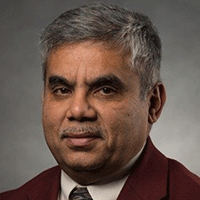
Professor Rakesh Kapania
Fellow, AIAA and the Royal Aeronautical Society
Presenting in Track 5: Advances in Aerospace Technology
Presentation Title: Learning From Nature: Bioinspired Design of Thin-Walled Structures Using Curvilinear Stiffening
Abstract: Humans are constantly striving to reduce the weight of thin-walled structures used in automobile, marine, and aerospace structures to improve their performance such as reduced-fuel consumption and increased payload. A constant source of inspiration for achieving this goal is nature, where curvilinear stiffening is used to stiffen and strengthen thin-walled structures. Until a few years ago, designing and fabricating curvilinearly stiffened thin-walled structures was nearly impossible; achieving optimal designing was difficult because of the need for enormous computational power, and fabrication was almost impossible because of the unavailability of affordable approaches to precisely fabricate curvilinearly stiffened plates and shells. The availability of high-performance computing, including Graphical Processing Units and machine learning, now makes it possible to optimally design curvilinearly stiffened structures. Additionally, the availability of additive manufacturing now allows us to fabricate these structures. For nearly two decades years, the speaker and his research group have been involved with research on using advanced computing and machine learning to design structures, both metallic and composites, with curvilinear stiffening. The optimal design includes constraints on buckling, displacement, stress, crippling, damage tolerance, acoustics, aeroelasticity, crack growth analysis, minimum thickness for manufacturing, integration of flaw effects, and manufacturing distortion. The talk will also describe the approaches used to achieve the optimal design of panels. In addition, we will also present the results of our research on reinforcing the wing structure using curvilinear Spars and Ribs, which we have termed as SpaRibs.
Biography: Dr. Rakesh K. Kapania graduated from Purdue University with a Ph.D. in Aeronautics and Astronautics in 1985. As an expert on aerospace structures, Dr. Kapania has made very significant contributions to aerospace engineering, in general, and aerospace structures, in particular. For the last three decades, he has served as a teacher, scholar, and researcher. Many of his undergraduate students are working in U.S. industry, and his trained researchers are working in academia, industry, and government labs. He has guided 68 M.S., 56 Ph.D., students to completion and has mentored 19 post-doctoral fellows.
Dr. Kapania has authored over 225 archival journal articles published primarily by AIAA, 380+ conference papers and presentations largely at the SDM conference and AIAA SciTech Forum, and two book chapters. He is currently serving as an associate editor of the AIAA Journal, and as a member of the AIAA Education Book Series advisory board, has served on the AIAA’s Structures Technical Committee, NRC Review Panel for NASA's Roadmap for future research, and member of the Daniel Guggenheim Medal Award Board.
Dr. Kapania has managed 113 research projects funded by many agencies. He led two large programs contributing to the design of both civilian and military future aerospace vehicles including a three-year $3.3 Million, NASA-Virginia Tech-Lockheed Martin program on Unitized Structures fabricated by modern manufacturing processes such as the Electronic Beam Free Form Fabrication, laser sintering, and other methods; and AFRL-Virginia Tech-Wright State University Collaborative Center on Multidisciplinary Sciences over 6.5 years at a level of $6.5M. Leading a team of 16 graduate students, he is contributing significantly to basic and applied research in aerospace structures in unitized structures, multidisciplinary design of truss-braced aircraft, highly-flexible wings and composite structures. He was also a part of a team selected by NASA on a multi-institution, five-year research project on mission adaptive aeroelastic wings. Dr. Kapania has been widely recognized for his contributions to aerospace education and research. He was honored by the Mitchell professorship. For his research contributions, Dr. Kapania was awarded the Dean's Award for Excellence in Research in 2000 and 2010. In 1996, he received the Boeing's Welliver Fellowship for his commitment to undergraduate education. Dr. Kapania was awarded the Boeing Research and Technology Performance and Innovation Award in 2014 for his research on nonlinear aeroelasticity of Truss-Braced Wings. His alma mater the Purdue University awarded him an Outstanding Aerospace Award and the Indian Institute of Science as a distinguished alumnus of the Department of Aerospace Engineering.
Dr. Kapania is a Fellow of the AIAA and the Royal Aeronautical Society.